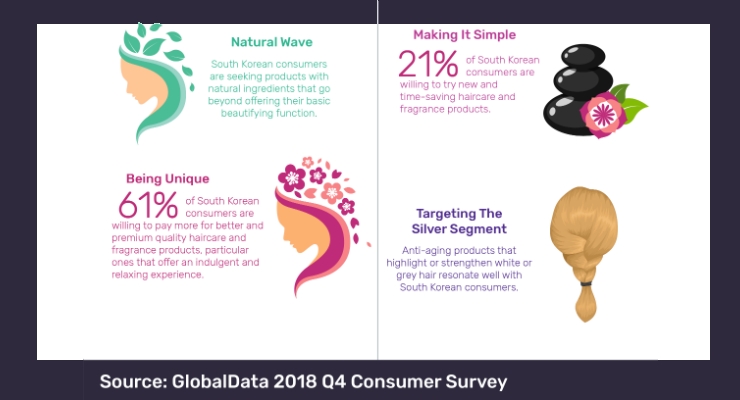08.05.19
The haircare sector has undergone a significant transformation over the past decade and it continues to evolve. Cosmetics & Toiletries companies are exploring new ways to diversify and retool their product offerings following shifts in consumer attitudes towards natural products, as well as making significant investments to boost ethical standards.
Sumit Chopra, consumer research director at GlobalData, a leading data and analytics company, highlights four major innovation trends that are set to impact South Korea’s haircare sector in 2019 in terms of production, marketing and sales.
Natural Wave
Consumers in South Korea are seeking natural ingredients such as botanical/herbal extracts to use in their daily haircare products. In line with the current demand for natural products, manufacturers are introducing haircare products which are “free from” silicones, sulfates, parabens and artificial color and fragrances to foster consumer trust and loyalty. Hence, haircare products that go beyond their basic beautifying function are growing in popularity. For instance, France-based Klorane launched anti-yellowing shampoo with high levels of cyanocentaurein (a plant-based pigment with blue tints) in South Korea for white and gray hair.
Being Unique
South Korean consumers are looking for innovative products, which offer an indulgent and relaxing experience. According to GlobalData’s 2018 Q4 Consumer Survey, 61% of South Korean consumers are willing to pay more for better and premium quality haircare and fragrance products. Therefore, manufacturers are capitalizing on this trend and offering products with special formulations and exclusive ingredients. South Korean beauty brand Skinfood launched Argan Oil Silk Hair Essence with unique ingredients such as argan oil, which helps in strengthening and softening the hair.
Making it Simple
According to GlobalData’s 2018 Q4 Consumer Survey, 21% of South Korean consumers are willing to try new and time-saving haircare and fragrance products. Rising urbanization levels are inspiring busy South Koreans to look for simple and time-effective beauty regimens, leading to an increased demand for multi-functional products. Keeping this “more than one benefit” approach in mind, manufacturers are introducing a plethora of haircare products with multiple benefits. For example, Ryoe Korean launched Herbal Damage Care Hair Treatment mask, which helps in coating the hair with strengthening ingredients like camellia oil, and adds moisture and shine to strands immediately after the first usage.
Targeting the Silver Segment
It is crucial for brands to persuade consumers about the effectiveness of anti-aging items as older consumers in South Korea resonate well with anti-aging products, particularly ones that highlight or strengthen white or grey hair. Haircare brands should seek to engage consumers through offerings that target specific hair issues such as thinning hair, dull hair and lack of hair volume, which are often related to aging. For example, Grafen launched Cold Booster in 2018 to tackle the issue of hair loss and other hair aging problems resulting from having a high scalp temperature.
Sumit Chopra, consumer research director at GlobalData, a leading data and analytics company, highlights four major innovation trends that are set to impact South Korea’s haircare sector in 2019 in terms of production, marketing and sales.
Natural Wave
Consumers in South Korea are seeking natural ingredients such as botanical/herbal extracts to use in their daily haircare products. In line with the current demand for natural products, manufacturers are introducing haircare products which are “free from” silicones, sulfates, parabens and artificial color and fragrances to foster consumer trust and loyalty. Hence, haircare products that go beyond their basic beautifying function are growing in popularity. For instance, France-based Klorane launched anti-yellowing shampoo with high levels of cyanocentaurein (a plant-based pigment with blue tints) in South Korea for white and gray hair.
Being Unique
South Korean consumers are looking for innovative products, which offer an indulgent and relaxing experience. According to GlobalData’s 2018 Q4 Consumer Survey, 61% of South Korean consumers are willing to pay more for better and premium quality haircare and fragrance products. Therefore, manufacturers are capitalizing on this trend and offering products with special formulations and exclusive ingredients. South Korean beauty brand Skinfood launched Argan Oil Silk Hair Essence with unique ingredients such as argan oil, which helps in strengthening and softening the hair.
Making it Simple
According to GlobalData’s 2018 Q4 Consumer Survey, 21% of South Korean consumers are willing to try new and time-saving haircare and fragrance products. Rising urbanization levels are inspiring busy South Koreans to look for simple and time-effective beauty regimens, leading to an increased demand for multi-functional products. Keeping this “more than one benefit” approach in mind, manufacturers are introducing a plethora of haircare products with multiple benefits. For example, Ryoe Korean launched Herbal Damage Care Hair Treatment mask, which helps in coating the hair with strengthening ingredients like camellia oil, and adds moisture and shine to strands immediately after the first usage.
Targeting the Silver Segment
It is crucial for brands to persuade consumers about the effectiveness of anti-aging items as older consumers in South Korea resonate well with anti-aging products, particularly ones that highlight or strengthen white or grey hair. Haircare brands should seek to engage consumers through offerings that target specific hair issues such as thinning hair, dull hair and lack of hair volume, which are often related to aging. For example, Grafen launched Cold Booster in 2018 to tackle the issue of hair loss and other hair aging problems resulting from having a high scalp temperature.













